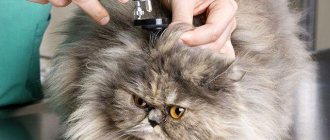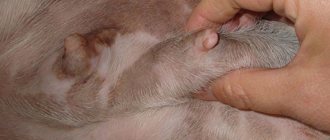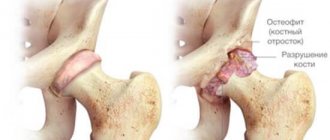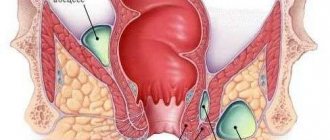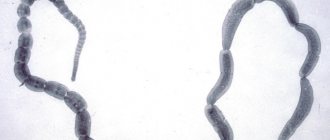Prevention of most diseases involves regular treatment against ectoparasites, but only a few know what products for dogs are on sale and how to use them correctly. Lack of knowledge about this procedure is completely normal for novice dog owners, but for more experienced ones it is a serious reason to rethink their existing care. Small pests can cause quite serious troubles, so you shouldn’t turn a blind eye to their existence.
External parasites that are dangerous for dogs
External parasites settle in hairs or directly on the skin, being kept from falling by special spikes, suction cups or claws. Some species feed on the blood of different victims, while others become attached to a specific host.
Fleas
These blood-sucking insects are distinguished by their jumping ability. Their record jumps reach 33 cm in length and 20 cm in height. For this reason, they easily change the host's body if necessary.
Fleas pierce the epidermis with their proboscis, injecting a special enzyme that slows down blood clotting. After feeding, they swell greatly, which makes them easier to diagnose. The appearance of these insects resembles black or brown dandruff.
Unlike most ectoparasites, flea enzyme does not contain an analgesic. The bite causes pain to the animal and provokes allergies. Fleas also often carry infections, infecting their victims with endocarditis, helminthiasis, rickettsiosis and other dangerous diseases.
Ticks
These ectoparasites are the only ones from the group of arachnids. They are distinguished from insects by an additional (fourth) pair of limbs. Existing species differ in size, feeding method and location.
Ixodidae
The largest (up to 3 cm) and dangerous parasites that carry in their body the pathogens of piroplasmosis, Lyme disease, encephalitis and ehrlichiosis. All these infections cause irreversible neurological and hematological disorders that can only be treated at an early stage.
Unlike other species, ixodid ticks do not become attached to one host. After saturation, they leave his body in search of a new victim.
Scabies
The body length of scabies mites does not exceed 0.45 mm. They get under the skin from the external environment or live there from the very birth of the animal. The first group includes:
- Sarcoptes scabiei
, which causes sarcoptic mange. It parasitizes the entire surface of the body, gnawing passages in the epidermis to lay eggs. From the outside, the tunnels look like thin light gray lines with a bubble at the end.
- Notoedres cati
, causing notoedrosis. Lives on the neck, head or limbs. The itching from the bites is less than with sarcoptic mange. Because of this, an infected dog may not itch, but constantly lick itself.
- Cheyletiella yasguri
, causing cheyletiosis. This mite, like Sarcoptes scabiei, affects the entire body, but prefers to lay its eggs on the hairs of the host.
The second group includes the intradermal mite demodex canis. Its pathogenicity manifests itself only with a sharp decrease in immunity. The demodicosis it causes is accompanied by redness and cracking of the skin, as well as the appearance of suppuration and ulcers.
Due to numerous wounds, tick infestation is often complicated by bacterial infestation. The addition of a secondary infection reduces the chances of recovery by up to 50% and increases the likelihood of death from sepsis.
Ear
The otodectes cynotis mite parasitizes strictly on the inner surface of the ear, since it does not survive on other parts of the body. In addition to blood, its diet includes dead particles of the epidermis.
Infection with this parasite can be recognized by dark brown pus inside the ears and frequent shaking of the head. Delayed treatment can lead to hearing loss, so you should immediately seek help after alarming symptoms appear.
lice eaters
An alternative name for these parasites is lice eaters. It is explained by the type of their diet. Instead of blood, they eat fur and epidermal particles. The mouthparts of lice eaters are not adapted for piercing the epidermis, which distinguishes them from fleas and ticks. Blood feeding is possible only with strong scratching.
The appearance of lice eaters resembles white dandruff. They differ from their closest relatives, lice, by the absence of wings.
Infection with these insects is accompanied by mild itching, thickening of the skin, deterioration in the appearance of the coat and weakened immunity. Without timely treatment, the animal’s condition is complicated by anemia, allergies, helminthiasis, exacerbation of chronic pathologies and secondary infections.
Lice
An infestation of lice is called pediculosis. It is accompanied by severe itching, dandruff, partial baldness and deterioration of the skin. Due to numerous injuries and scratches, the disease is often complicated by suppuration and secondary infections.
Like lice eaters, lice feed on particles of the epidermis and hairs. In addition to dead cells, their diet also consists of absolutely healthy ones, which they tear off with their powerful jaws. Unlike fleas, lice do not know how to suck blood, but enjoy it with pleasure when a sufficient number of wounds appear on the dog’s body.
Mosquitoes
A mosquito bite causes swelling, itching and allergic dermatitis. Also, the insect often carries eggs or larvae of hypodermic worms. These parasites infect the lungs and heart of the animal, causing thrombosis and embolism.
Hemiparasites
There is a fairly large group of plants that have partially or completely lost the ability to absorb water and minerals from the soil, but have retained the ability to carry out photosynthesis. Such plants are called hemiparasites . Examples of them are plants of the genera eyebright (Euphrasia), rattle (Rhinantus), mystle (Pedicularis) of the family Scrophulariaceae and some others.
On this page there is material on the following topics:
Endoparasites and their adaptations
Stationary ectoparasites of animals
J,ofz [fhfrnthbcnbrf rkjgjd
Parasitism biology examples
Concepts endo and ectoparasites representatives
Questions about this material:
What type of relationship between organisms is called parasitism?
Give examples of plants and animals that interact with each other according to the type of parasitism.
What are ectoparasites and endoparasites?
What means will protect your pet?
It is much easier to take care of protecting your four-legged pet in advance. To do this, it is necessary to select an effective acaricide against ectoparasites.
Drops on the withers and ears
Depending on the type of parasite, the drug (Hartz, Fiprex, Barrier, Mister Bruno, Advantix) is applied to the withers or dripped into the ears. The second option is suitable for the prevention of otodectosis.
The drops are attractive due to their economical consumption and quick action. Their only drawback is the high likelihood of an allergic reaction.
Sprays
Unlike drops, a spray (Acaromectin, Stronghold, Frontline) must be covered over the entire body of the pet, which greatly increases consumption. But this product is suitable not only for treating skin, but also for contaminated surfaces (bedding, house, clothing).
For dogs with long hair, it is better to apply a double dose. Otherwise, the liquid may settle on the top layer of hairs and not reach the skin.
Shampoos
The safest form of release that does not cause allergies. Due to their gentle effect, shampoos (Bars, Greenfort, Bolfo) are suitable exclusively for treating infection at the initial stage. The drug is almost immediately washed off the surface, so it is not suitable for prevention, and too frequent bathing can aggravate existing problems with the skin and coat.
Collars
The effect of collars (Foresto, Kiltix, Beafar) is the longest lasting. They last for more than six months and for some time after removal, but more often than other drugs they cause allergies. If hair falls out, they should be replaced with safer analogues.
Collars repel parasites with an unpleasant odor or ultrasound. The second option is more expensive, but safer. It is suitable for pregnant and lactating dogs, pets with chronic diseases and puppies under 2 months. All these animals are difficult to tolerate insecticides contained in chemical collars, so ultrasound is the only safe option for them.
Tablets and chewable pads
The effect of the tablets (Bravecto, Nexgard, Simparica, Merial, Zoetis) is quite long-lasting, and their active substance not only kills the pest, but also blocks the development of secondary infections. Some types of this drug are suitable for animals at risk.
The only disadvantage of the tablets is the difficulty of feeding. Veterinarians recommend using the drug in the form of chewable pads with a meat flavor. Thanks to their pleasant aroma, many pets eat them on their own.
General recommendations and prevention
To prevent and destroy the listed parasites, insecticidal and acaricidal (anti-mite) drugs are used; the products are sold in veterinary pharmacies and pet stores. It is better to find out which drug is better in each specific case from your veterinarian.
For pregnant bitches, puppies, sick and weakened animals, special medications are selected. It is important to clean your home regularly and thoroughly. During walks, the dog should not be allowed to come into contact with stray animals. To prevent infection by ticks and fleas, anti-flea and anti-tick collars are used.
How often should I treat for ectoparasites?
The frequency of processing depends on the end goal. If the drug is used for treatment, it is applied twice. Repeated application allows you to get rid of larvae that have hatched from eggs and prevent re-laying.
For the purpose of prevention, the acaricidal agent is applied before mating, vaccinations and during the period of increased parasite activity, which lasts from mid-spring to mid-autumn. Depending on the release form, the processing frequency is:
- Once a month – drops, tablets;
- 1 time per day - sprays.
Collars are worn before going outside or worn on an ongoing basis. The use of shampoo is acceptable as an additional measure or as prescribed by a veterinarian.
Animals at risk with weakened immune systems are recommended to be treated on an individual schedule. It should be agreed with the attending physician to exclude adverse reactions to the components included in the composition.
Please note that repeated use of the same drug reduces its effectiveness. Periodic switching to other brands will help to avoid resistance (that is, resistance).
Ticks
There are typically three types of ticks that infect dogs: Demodex, Sarcoptes and encephalitis. Parasites are dangerous for animals and humans.
Demodex mites cause demodicosis and settle and multiply in hair follicles and sebaceous glands. More often, dogs become infected in the first months of life, when the skin is thin and the hair is short. In the future, long hair interferes with the movement of ticks. Able to pass from mother to puppies during feeding. Demodicosis sometimes goes away on its own, but without treatment it becomes severe when internal organs are affected. Can lead to the death of the animal.
